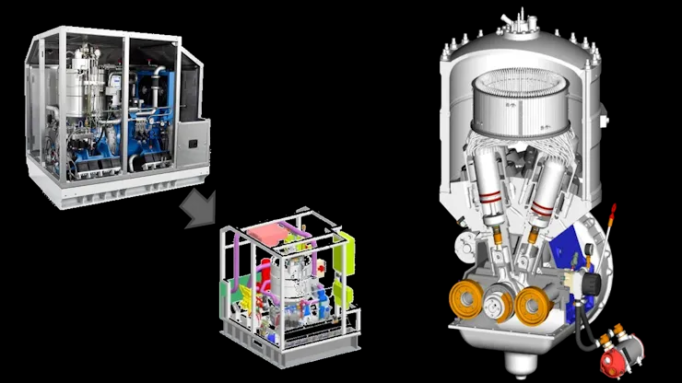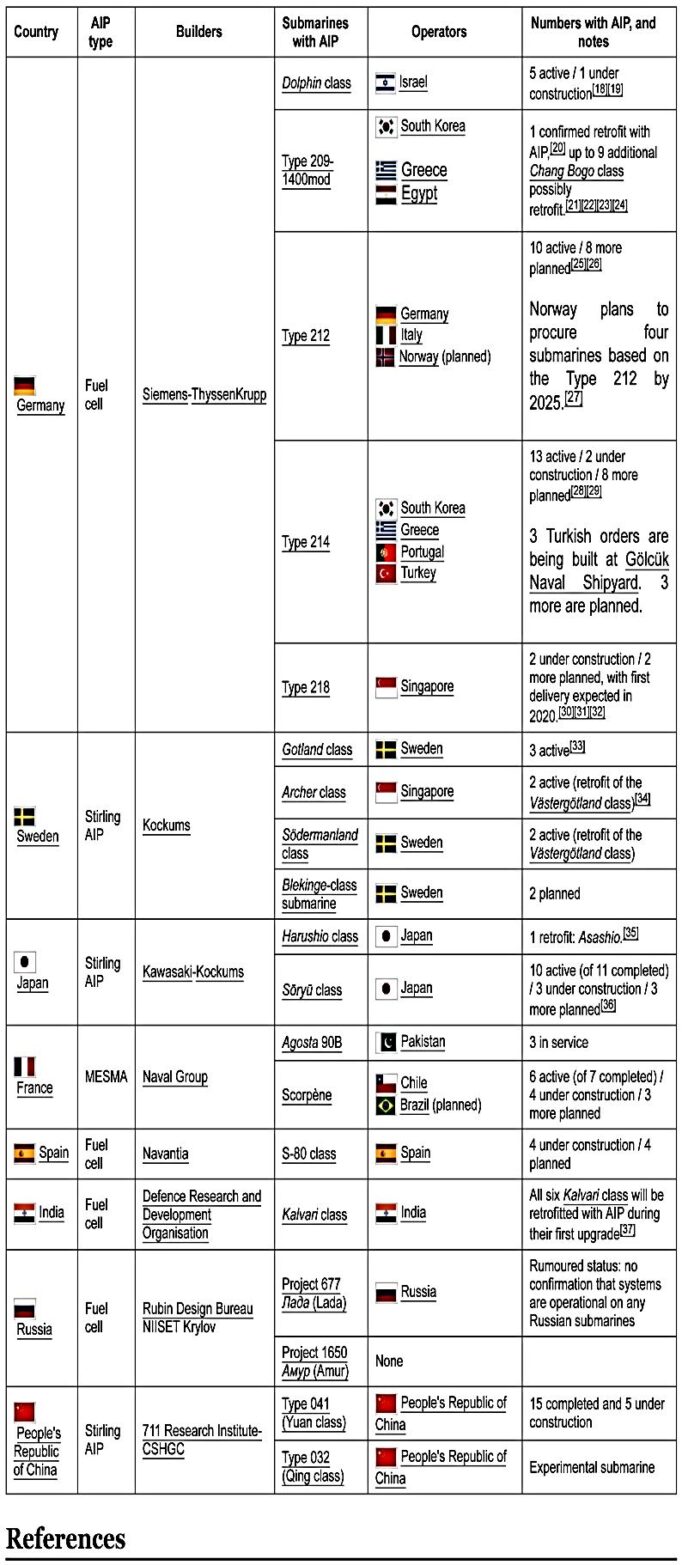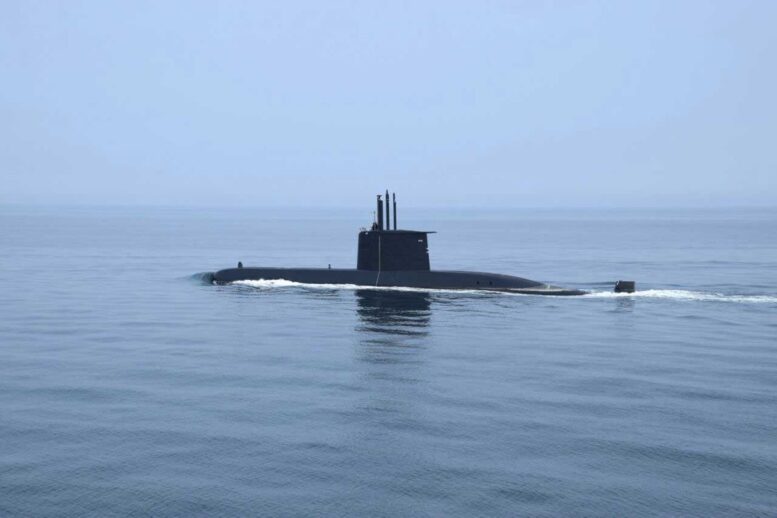Introduction. The Diesel Electric Submarine was considered as a principal weapons system of naval warfare, especially in littoral waters. Submarine designers and builders focused their design in making them capable to operate, run silent and run deep, with increasing underwater endurance. Diesel Electric Submarines need to surface and link to the atmospheric oxygen to supply air for the generators to charge their batteries and be capable to achieve longer underwater endurance.
New developments in battery technology has improved significantly in extended submerged endurance underwater, but not enough to last beyond a week. The Introduction of the Air Independent Propulsion (AIP) gave a distinct advantage to improve underwater endurance. For this reason, majority of world navies opted to acquire and build new generations of diesel electric submarines with Air Independent Propulsion, which can be integrated and inserted in between the hull section by segment in the pressure hull of both single hull and double hull diesel electric submarine.
This article is a research paper extracted from various reading materials and from my study papers on submarine design submitted as a requirement at the Department of Naval Architecture, University College of London, United Kingdom, Great Britain way back in 1998 under the sponsorship of the UK Ministry of Defense. It seeks to give a comparative view of the Diesel Electric Submarine with an AIP system versus the nuclear-powered submarine.
Effectiveness of a Submarine. Stealth in littoral waters is the primary reason for the acquisition of a diesel electric submarine. It is the most feared adversary of surface combatant Ship Naval Commanders in the area of conflict at sea. Diesel electric submarine can operate, run silent and run deep from extremely shallow water up to a depth of 250-300 meters, almost the limitation of diesel submarine hull crushing or collapsed depth.
The invincibility of a diesel electric submarine is when her presence in the arena of conflict at sea is not detected. But once her presence is located with the specific depth, bearing, and rate of movement and direction, her effectiveness as a weapons system is greatly diminished, and is at the mercy of the anti-submarine ship. Instead of the hunter, she becomes the hunted.
The stealth of a diesel electric submarine is dependent on the emission of acoustic signatures from her propeller, the internal combustion engine vibration, opening of the bow door of the torpedo tubes, concentration of a heavy marine growth at the outer hull surface in the contact with seawater while moving underwater, crew activities onboard the submarines, etc., all contributing to the vulnerability of being detected within the underwater battle envelope of the surface ships and other submarines.
Modern up-to-date anti-submarine warfare in the underwater dogfight between submarine against another submarine focus on how they can deflect each other, through the combat reputation of their torpedoes with acoustic homing guidance system, and counter measures’ ability to create and simulate a false target to deceive, distract, and avoid being hit by a deadly homing torpedo underwater.
Diesel Electric Propulsions System Code Designation SSK. There are variants of diesel electric propulsion systems developed per the submarine’s country of origin. One is the Diesel electric submarine type code designation SSK, the Diesel Attack Submarine:
- French Diesel Electric Submarine – the MESMA (Module d’Energie Sous Marine Autonomy) (Autonomous Submarine Energy Module) is the propulsion system of the Scorpene Class Submarine that we envisioned to acquire for the PN is an Air Independent Propulsion (AIP) system which makes use of ethanol and oxygen as energy sources to run the turbine with higher power output. The drawback is its lower efficiency and oxygen consumption is to be high and the system is very complex.
- Swedish Diesel Electric Submarine – a closed cycle engine with a working fluid which is permanently contained in the system. A source of energy used to heat the working fluid, which in turn moves the piston and runs the engine coupled with a generator which then produces electricity and charges the battery with low refueling cost and is very silent. MESMA is used by Japanese Sub SORYU Class, Sweden for Gotland Class, and Yuan Class of China.
German Diesel Electric Submarine – uses a fuel cell which converts chemical energy to electricity. It uses fuel as oxidizer into the electricity with water, and the heat released is the by-product. This is done by an electrolytic cell with two electrodes (negative and positive). The reaction produces a current that is used to charge batteries. PEM Cell (Proton Exchange Membrane Fuel Cell) also known as Polymer Electrolyte Membrane is fuel for Submarine Air Independent Propulsion System. It does not need to connect to Atmospheric Oxygen and can operate through chemical reaction to charge batteries of submarines.

Fig. 1 MESMA (Module d’Energie Sous-Marine Autonome/Autonomous Submarine Energy Module)

Fig. 2 Sterling Engine Closed Cycle Engine with a Working Fluid Permanently Contained Within the System
Advantages of the Air Independent Propulsion (AIP) System and Nuclear Power Submarines:
- The AIP System on a Diesel Electric Submarine significantly enhances underwater operations endurance, permits the submarine to stay submerged underwater for several weeks, approximately 3-4 weeks depending on power consumption load on speed without going surface to charge batteries. Their underwater endurance gives advantages to other non-AIP equipped diesel electric submarines and cannot replace the nuclear reactor of nuclear submarines. But the AIP Diesel Electric Submarine can dominate in extremely shallow littoral waters.
- A Nuclear Submarine can travel for an unlimited range at maximum speed of 30-35 knots underwater without surfacing for months. The AIP cannot replace the nuclear submarine and is incomparable in terms of enormous amount of power source when it comes to blue and deep water operation for extended periods of operation specially in the open ocean, above in the arctic, and below in the Antarctic region of vast sea areas.

Fig. 3 Fuel Cells Using Fuel Oxidizer
Examples of Conflict Scenarios:
- The Diesel Electric Submarine type code designation SSK, is a small to medium sized submarine ranging between 1,500 to 3000 tons displacement, capable of hiding in underwater terrain, stationary and quiet in ambush position in extremely shallow water against coming hostile submarine and surface battle fleet. Said submarine is difficult to detect in the littoral waters with heavy maritime traffic, noise emanating from land activities, and variable sea conditions such as water salinity and other coastal/shore activities. However, these can also affect SONAR reception, which can make it difficult for the submarine to conclude whether to launch a deliberate torpedo attack or not.
- Nuclear Submarine Type Code designation SSBN (submersible ship ballistic missile nuclear), provides the principles of strategic deterrence, capable of carrying nuclear warheads in the missile launch vertical silo. Nuclear submarines can also operate in littoral waters during peacetime. But during conflict situation, it cannot take unacceptable risks to operate under certain circumstances in shallow waters. This type of submarine emits a constant acoustic signature because of continuous operation of seawater pumps for the cooling system of the nuclear reactor to prevent possible meltdown. The Displacement of OHIO Class and Virginia Class submarines is approximately 16,600 tons surface and 18,750 dive condition.

Table 1 Listing of Diesel Electric Submarine with Variant of Propulsion System
Conclusion. The Diesel Electric Submarine equipped with current technology and AIP can only be used during conflict scenario deployment, and not necessary to use during peacetime patrol operation. An AIP-equipped submarine can use a snorkel to connect to the atmospheric oxygen to recharge batteries during patrol in non-hostile territories. Most fuel and other oxidants and consumables are quite expensive and therefore are not practical to be replenished on a routine basis.
The endurance and reliability of current battery technology permits more considerable submerge time for AIP submarines to operate underwater.
However, a Diesel Electric Submarine with known limitations in endurance and power is incomparable to a Nuclear Submarine’s power and endurance underwater, which is a true AIP but with more capabilities.
References:
- Defencyclopedia, The Ultimate Defense Encyclopedia,
6-July-2016 by NRP. - Janes Fighting Ship Manual, 1992-1993. Publication by Capt. Richard Sharpe RN.
- Air Independent Propulsion.
About the Researcher/Editor:
CAPT TOMAS D BAINO PN (Ret) completed his post-graduate studies in Submarine Design at the Department of Naval Architecture, University College of London, United Kingdom of Great Britain under the sponsorship of educational grant of UK Ministry of Defense. Also attended the Ship System Survivability Orientation with Defense Evaluation Research Agency (DERA) of UK Ministry of Defense in London and MEKO Frigate design and construction in Hamburg, Germany. Capt Baino is an member of the Editorial Board of the Maritime Review, providing series of articles on Naval Ship Design, and served as Naval Architect Consultant with the Department of Transportation and Philippine Coast Guard Project Management Office in Ship Acquisition Program from 2017 to 2020.
